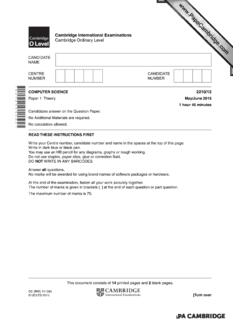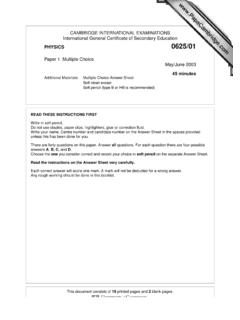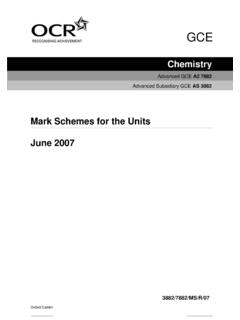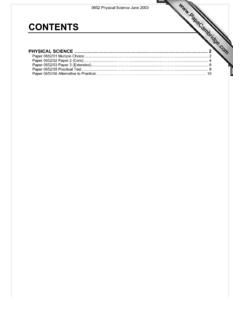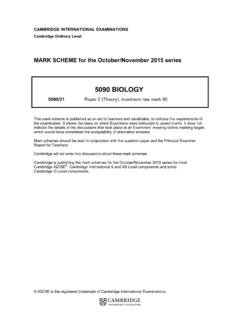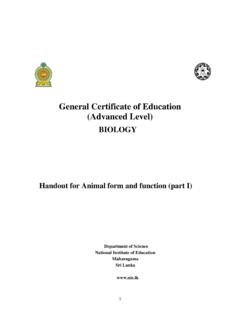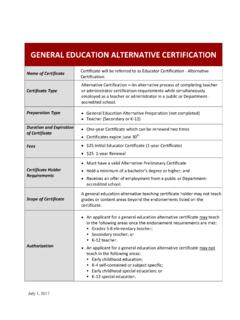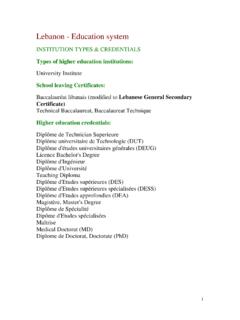Transcription of General Certificate of Education (A-level) June 2012
1 Version General Certificate of Education (A-level). June 2012. Biology BIO6T/Q12. (Specification 2410). Unit 6T: Investigative Skills Assignment. FINAL. Marking Guidelines Marking Guidelines are prepared by the Principal Moderator and considered, together with the relevant questions, by a panel of subject teachers. Further copies of this Mark Scheme are available from: Copyright 2012 AQA and its licensors. All rights reserved. Copyright AQA retains the copyright on all its publications. However, registered centres for AQA are permitted to copy material from this booklet for their own internal use, with the following important exception: AQA cannot give permission to centres to photocopy any material that is acknowledged to a third party even for internal use within the centre.
2 Set and published by the Assessment and Qualifications Alliance. The Assessment and Qualifications Alliance (AQA) is a company limited by guarantee registered in England and Wales (company number 3644723) and a registered charity (registered charity number 1073334). Registered address: AQA, Devas Street, Manchester M15 6EX. Final Marking Guidelines General Certificate of Education (A-level) Biology BIO6T/Q June 2012. Guidance for teachers marking Biology ISAs Final Marking Guidelines must be used to mark students work and these will be published on eAQA in October. General principles In General , you are looking for evidence that the student knows and understands the point required by the Marking Guidelines. It is important to mark what the student has written, not to assume what may have been intended.
3 It is also important to make sure that a valid point is in the correct context. Individual words or phrases where the overall answer does not apply to the question asked should not be credited. Conventions The following conventions are used in the Marking Guidelines. A semicolon (;) separates each marking point An oblique stroke (/) separates alternatives within a marking point Underlining of a word or phrase means that the term must be used For example anaphase, the term must appear For example .. and .., both items must be present for a mark Brackets are used to indicate contexts for which a marking point is valid. This context may be implied by a student's answer 'Accept' and 'reject' show answers which should be allowed or not allowed.
4 Additional instructions are shown in the final column Max refers to the maximum mark that can be awarded for a particular question or part question. The Marking Guidelines show the minimum acceptable answer(s) for each marking point. A. better, more detailed, or more advanced answer should always be accepted, provided that it covers the same key point. Marking Guidelines cannot give every possible alternative wording - equivalent phrasing of answers should be accepted. For example the water potential is higher in the cells is equivalent to the water potential is less negative in the cells . It is, however, important to be sure that the minimum requirement of the Marking Guidelines is met and that the point is made unambiguously.
5 Converse answers are normally acceptable, unless the wording of the question rules this out. For example, 'the water potential is lower in the solution is an acceptable converse of the water potential is higher in the cell . Very occasionally, a student will give a biologically correct answer that is not covered in the Marking Guidelines. If it is equivalent in standard to the Marking Guideline answers, it should be credited. In this case, write the word valid . All marking points are awarded independently, unless a link between points is specified in the Marking Guidelines. 3. Final Marking Guidelines General Certificate of Education (A-level) Biology BIO6T/Q June 2012. The mechanics of marking Always mark in red ink. Make sure that some red ink appears on every page on which the student has written.
6 For each mark awarded, put a tick close to the marking point. In all cases, a tick should equal one mark and the total number of ticks should match the mark totals in the margins. The total mark for each part answer should be written in the right hand margin. Put a cross against incorrect points. It is helpful to indicate omissions of key words or incomplete answers with a symbol, and to highlight irrelevancies or contradictions by underlining. It is also helpful to write brief comments to explain the reason for awarding or withholding a mark when the answer does not obviously match the Marking Guidelines. When marking answers with many marking points, the points will be numbered. The points do not have to appear in the student s response in the order in the Marking Guidelines.
7 The appropriate number must be placed alongside the tick. This helps to clarify where a specific point has been awarded and makes moderation much easier. It also helps to avoid awarding the same point twice. Disqualifiers A correct point should be disqualified when the student contradicts it in the same answer. Indicate this on the script by 'dq'. If a tick has already been placed against a valid point, ensure that it is clearly deleted. Note that there is no penalty for incorrect points which are not contradictory, or for surplus or neutral information. The list rule When a question asks for a specific number of points, and the student gives more, the General rule is that any wrong answer cancels a correct answer. For example, if a question asks for two points and three answers are given, two correct and one clearly wrong, the mark awarded is one, whatever the order of the answers.
8 This prevents students from gaining full marks from a list of right and wrong answers. Name two substances that are produced in photosynthesis. (2 marks). Answer Marks Comment Oxygen, glucose 2 Both correct Oxygen, carbon dioxide 1 One correct, one incorrect Carbon dioxide, oxygen, 1 Carbon dioxide is clearly incorrect and glucose cancels one of the marks Oxygen, glucose, water 2 Regard water as a neutral point. It is not worth a mark but it is not incorrect Two or more correct points on the same answer line should be credited. 'Neutral' points, ones which are not creditworthy but not actually incorrect, should not negate a correct answer. Spelling Reasonably close phonetic spellings should be credited. However, any misspelling of technical terms which can easily be confused, such as intermediate between mitosis and meiosis , should result in the relevant marking point being withheld.
9 Terms like this will be indicated in the final column in the Marking Guidelines to show that misspellings must not be credited. 4. Final Marking Guidelines General Certificate of Education (A-level) Biology BIO6T/Q June 2012. BIO6T/Q12 TASK. Before you mark any work, please make sure that you have read Guidance for teachers marking Biology ISAs on pages 3 and 4 of these Marking Guidelines. Stage 1. The table of raw data collected during implementation is required for moderation and must be attached to the ISA test. (NB no marks are awarded for the table, Stage 1, at A2). Stage 2 - Assessment of statistical analysis Question Marking guidance Mark Comments 1 Clear statement of null hypothesis; 1 temperature has no effect on respiration in yeast / any difference in the rate of respiration of yeast at different temperatures is due to chance.
10 2(a) Standard error (and 95% 1 Accept answers such as confidence limits); Standard error that clearly identify the test concerned from the statistics sheet. Reject: Standard Deviation 2(b) Comparing means; 1. 3 Test statistic calculated correctly; 1. 4 1 Probability greater than / 5% 2 Use student s value of test that results are due to chance; statistic even if it has been calculated incorrectly. 2 Accept null hypothesis;. OR. 1 Must refer to both probability 1 Probability less than / 5%. and chance. that results are due to chance;. 2 Reject null hypothesis;. 1. Total 6. The Candidate Results Sheet: Stage 2 is required for moderation and must be attached to the ISA test. 5. Final Marking Guidelines General Certificate of Education (A-level) Biology BIO6T/Q June 2012.

